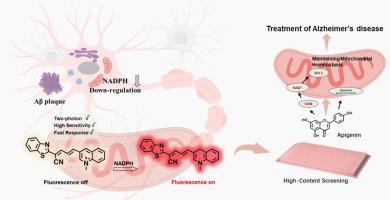当前位置:
X-MOL 学术
›
Chem. Eng. J.
›
论文详情
Our official English website, www.x-mol.net, welcomes your feedback! (Note: you will need to create a separate account there.)
A two-photon fluorescent probe sensitive to NADPH reveals metabolic aberrations in brain cells arising from mitochondrial dysfunction in Alzheimer’s disease
Chemical Engineering Journal ( IF 13.3 ) Pub Date : 2024-07-01 , DOI: 10.1016/j.cej.2024.153652 Xueao Wang , Yani Liu , Subin Kim , Chenrun Zhang , Zheng Li , Chen Xu , Hai-Liang Zhu , Yong Qian
Chemical Engineering Journal ( IF 13.3 ) Pub Date : 2024-07-01 , DOI: 10.1016/j.cej.2024.153652 Xueao Wang , Yani Liu , Subin Kim , Chenrun Zhang , Zheng Li , Chen Xu , Hai-Liang Zhu , Yong Qian

|
Mitochondrial dysfunction is implicated in the pathogenesis of numerous neurodegenerative disorders, including Alzheimer’s disease (AD). Nicotinamide adenine dinucleotide phosphate (NADPH) plays a crucial cofactor as a cofactor in diverse biological processes, with the interconversion between NADP and NADPH serving a pivotal function in intracellular reductive metabolism and redox homeostasis. Herein, we present a fast, ultrasensitive, two-photon fluorescent probe (NATP-3) with large Stokes shifts for real-time detection of NADPH levels in mitochondria of the brain cells and elucidate mitochondrial damage in AD. Significantly reduced levels of NAD(P)H in living brain cells under Aβ stress or in AD model animals such as were intuitively observed, suggesting that cellular mitochondrial dysfunction and metabolic disorders in the brain are closely related to AD. Importantly, utilizing a high-throughput screening platform based on NATP-3, we identified apigenin as a promising candidate for mitigating mitochondrial dysfunction in AD. Notably, apigenin reinstates mitochondrial NAD(P)H production, thereby providing a potential entity molecule for intervening in mitochondrial damage during AD. This work provides a valuable tool for detecting and intervening in mitochondrial function and metabolic homeostasis associated with AD processes, emphasizing the importance of understanding the molecular mechanisms of mitochondrial dysfunction associated with neurodegenerative diseases.
中文翻译:

对 NADPH 敏感的双光子荧光探针揭示了阿尔茨海默病线粒体功能障碍引起的脑细胞代谢异常
线粒体功能障碍与许多神经退行性疾病的发病机制有关,包括阿尔茨海默病 (AD)。烟酰胺腺嘌呤二核苷酸磷酸 (NADPH) 在多种生物过程中发挥着重要的辅助因子作用,NADP 和 NADPH 之间的相互转化在细胞内还原代谢和氧化还原稳态中发挥着关键作用。在此,我们提出了一种快速、超灵敏、具有大斯托克斯位移的双光子荧光探针 (NATP-3),用于实时检测脑细胞线粒体中的 NADPH 水平,并阐明 AD 中的线粒体损伤。直观地观察到,在 Aβ 应激下的活体脑细胞或 AD 模型动物中,NAD(P)H 水平显着降低,这表明细胞线粒体功能障碍和大脑代谢紊乱与 AD 密切相关。重要的是,利用基于 NATP-3 的高通量筛选平台,我们确定芹菜素是缓解 AD 线粒体功能障碍的有希望的候选者。值得注意的是,芹菜素可恢复线粒体 NAD(P)H 的产生,从而为干预 AD 期间的线粒体损伤提供潜在的实体分子。这项工作为检测和干预与 AD 过程相关的线粒体功能和代谢稳态提供了一个有价值的工具,强调了了解与神经退行性疾病相关的线粒体功能障碍分子机制的重要性。
更新日期:2024-07-01
中文翻译:

对 NADPH 敏感的双光子荧光探针揭示了阿尔茨海默病线粒体功能障碍引起的脑细胞代谢异常
线粒体功能障碍与许多神经退行性疾病的发病机制有关,包括阿尔茨海默病 (AD)。烟酰胺腺嘌呤二核苷酸磷酸 (NADPH) 在多种生物过程中发挥着重要的辅助因子作用,NADP 和 NADPH 之间的相互转化在细胞内还原代谢和氧化还原稳态中发挥着关键作用。在此,我们提出了一种快速、超灵敏、具有大斯托克斯位移的双光子荧光探针 (NATP-3),用于实时检测脑细胞线粒体中的 NADPH 水平,并阐明 AD 中的线粒体损伤。直观地观察到,在 Aβ 应激下的活体脑细胞或 AD 模型动物中,NAD(P)H 水平显着降低,这表明细胞线粒体功能障碍和大脑代谢紊乱与 AD 密切相关。重要的是,利用基于 NATP-3 的高通量筛选平台,我们确定芹菜素是缓解 AD 线粒体功能障碍的有希望的候选者。值得注意的是,芹菜素可恢复线粒体 NAD(P)H 的产生,从而为干预 AD 期间的线粒体损伤提供潜在的实体分子。这项工作为检测和干预与 AD 过程相关的线粒体功能和代谢稳态提供了一个有价值的工具,强调了了解与神经退行性疾病相关的线粒体功能障碍分子机制的重要性。











































 京公网安备 11010802027423号
京公网安备 11010802027423号